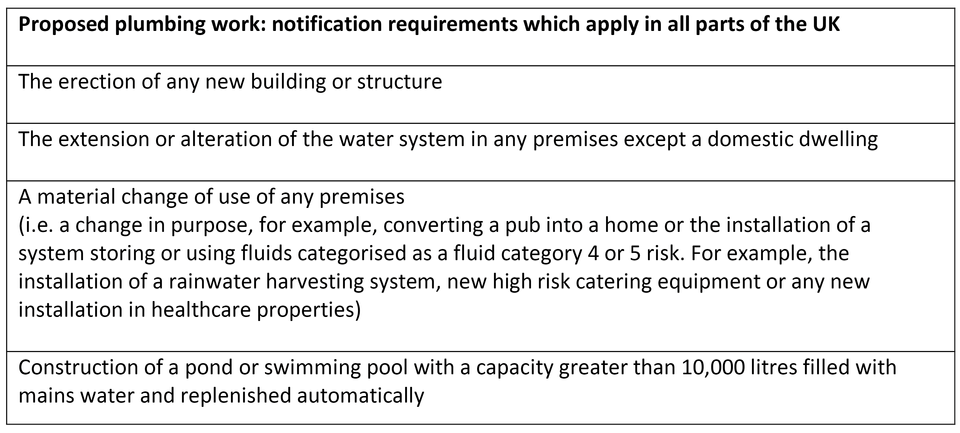
If a premises has any form of mains water supply, then in many cases the water fittings regulations in England, Wales and Northern Ireland, byelaws in Scotland, make it a legal requirement (regulation 5) for the local water undertaker to be given advanced notice of any proposed plumbing work. This is an important simple and essential check to minimise the risk to water supplies.
The water undertaker has 10 working days to respond to a valid notification. The proposed work should not start until after the 10 days is up.
The water undertaker can either decline or grant consent. If consent is granted conditionally then these conditions must be met.
If no response is received consent is deemed to have been granted. The proposed plumbing work can proceed but the owner/occupier has the legal obligation to ensure it is fully compliant with the water fittings regulations/byelaws.
If a premises has any form of mains water supply, then in many cases the water fittings regulations in England, Wales and Northern Ireland, byelaws in Scotland, make it a legal requirement (regulation 5) for the local water undertaker to be given advanced notice of any proposed plumbing work. This is an important simple and essential check to minimise the risk to water supplies.
The water undertaker has 10 working days to respond to a valid notification. The proposed work should not start until after the 10 days is up.
The water undertaker can either decline or grant consent. If consent is granted conditionally then these conditions must be met.
If no response is received consent is deemed to have been granted. The proposed plumbing work can proceed but the owner/occupier has the legal obligation to ensure it is fully compliant with the water fittings regulations/byelaws.
The conditions of consent will be found in the consent letter issued by the local water undertaker. This will have been sent to the address listed in the advanced notification.
If there are any questions relating to the approval granted, please contact the local water undertaker for further information
Although broadly similar there are differences in the notification requirements in England, Scotland, Wales and Northern Ireland. Any questions please contact the local water undertaker for advice.
Notification requirements which are the same in England, Wales, Scotland and Northern Ireland.


Many water undertakers have their own notification forms and dedicated contact information which can be found on the water undertaker’s website and here. It is important to use the local water undertakers form especially when submitting electronically.
If the local water undertaker does not provide a form, for a notification to be valid it must include as a minimum:
The name and address of the person giving notice and, if different, the name and address of the person to whom the consent should be sent.
A description of the proposed work or material change of use.
The location of the premises and their use or intended use.
If using an approved contractor their name
Except for the items highlighted below a plan of those parts of the premises which relate to the proposed work and a diagram showing the pipework and fittings to be installed.

Scottish Water has its own notification form and dedicated contact as well as other information which can be found here .
Any questions please contact Scottish Water for advice.
Please note except for the items highlighted below a plan of those parts of the premises which relate to the proposed work and a diagram showing the pipework and fittings to be installed will be required.

Northern Ireland Water has its own notification form and dedicated contact as well as other information which can be found here .
Any questions please contact Northern Ireland Water for advice.
Please note except for the items highlighted below a plan of those parts of the premises which relate to the proposed work and a diagram showing the pipework and fittings to be installed will be required.

A material change of use is defined in the water fittings regulations in England, Wales and Northern Ireland, byelaws in Scotland
It is a change in the purpose for which a premises is used or the circumstances in which water within that premises will be used, specifically the introduction of new systems or appliances which are categorised as posing a fluid category 4 or 5 risk.
For example:
The conversation of a house into a business premises or private business to a public building.
A change of business use
The installation of a new rainwater harvesting system, new high risk catering equipment or any new installation in healthcare.
For the purpose of the water fittings regulations in England, Wales and Northern Ireland, byelaws in Scotland an approved contractor is a member of one of the following schemes.
Chartered Institute of Plumbing and Heating Engineering (CIPHE)
Scottish and Northern Ireland Plumbing Employers’ Federation (SNIPEF)
Providing:
Their scheme is recognised by the local water undertaker
The proposed work is not a material change of use
The scope of their membership covers the type of plumbing work undertaken
They comply with their scheme terms and conditions
An approved contractor installing the items highlighted in the list below, may not have to provide advanced notification before starting work. However, on completion they will be required to send a certificate of compliance for the work to the local water undertaker as well as issuing one to their client.
Please note: notification exemptions for those approved contractors who are members of sector schemes is typically restricted to the alteration or extension of plumbing systems. For further information contact the scheme
Please note: due to both differences in notification requirements across the UK and variation in individual approved contractor schemes terms and conditions it is important to check whether advanced notification is required.

For the purpose of the water fittings regulations in England, Wales and Northern Ireland, byelaws in Scotland an approved contractor is a member of one of the following schemes.
Chartered Institute of Plumbing and Heating Engineering (CIPHE)
Scottish and Northern Ireland Plumbing Employers’ Federation (SNIPEF)
Providing:
Their scheme is recognised by Scottish Water
The proposed work is not a material change of use
The scope of their membership covers the type of plumbing work undertaken
They comply with their scheme terms and conditions
An approved contractor installing the items highlighted in the list below, may not have to provide Scottish Water with advanced notification before starting work. However, on completion they will be required to send a certificate of compliance for the work to Scottish Water as well as issuing one to their client.
Any questions please contact the Scottish Water for advice.
Please note: notification exemptions for those approved contractors who are members of sector schemes is typically restricted to the alteration or extension of plumbing systems. For further information contact the scheme
Please note: due to both differences in notification requirements across the UK and variation in individual approved contractor schemes terms and conditions it is important to check whether advanced notification is required.

For the purpose of the water fittings regulations in England, Wales and Northern Ireland, byelaws in Scotland an approved contractor is a member of one of the following schemes.
Chartered Institute of Plumbing and Heating Engineering (CIPHE)
Scottish and Northern Ireland Plumbing Employers’ Federation (SNIPEF)
Providing:
Their scheme is recognised by Northern Ireland Water
The proposed work is not a material change of use
The scope of their membership covers the type of plumbing work undertaken
They comply with their scheme terms and conditions
An approved contractor installing the items highlighted in the list below, may not have to provide Northern Ireland Water with advanced notification before starting work. However, on completion they will be required to send a certificate of compliance for the work to Northern Ireland Water as well as issuing one to their client.
Any questions please contact the Northern Ireland Water for advice.
Please note: notification exemptions for those approved contractors who are members of sector schemes is typically restricted to the alteration or extension of plumbing systems. For further information contact the scheme
Please note: due to both differences in notification requirements across the UK and variation in individual approved contractor schemes terms and conditions it is important to check whether advanced notification is required.

The requirement to notify the proposed installation of 'a pump or booster drawing more than 12 litres per minute, connected directly or indirectly to a supply pipe' applies to all pumps capable of delivering any flow rate greater than 12 litres per minute.
For example, a shower which is supplied with water through a pump (located either upstream or downstream of the mixing valve) capable of delivering more than 12 litres/minute.

Pipework should be laid at a depth of not less than 750 mm (to limit the effect of freezing and mechanical damage) and no greater than 1350 mm deep. They should be embedded in non-abrasive materials. Where this cannot be achieved in all circumstances the consent of the local water undertakers must be obtained via notification.
Where the local water undertaker consents to pipework being laid at less than 750 mm it should be installed as deep as possible below ground level and protected against warming, freezing and mechanical damage (for example due to ground movement).
Pipework should not be installed above ground level without the agreement of the local water undertaker.
When subjected to freezing temperatures all water fittings are at risk of fracturing, causing damage to property and a waste of water. To help prevent this it is essential any plumbing installation which might be exposed to cold conditions, including pipework laid at a depth of less than 750 mm, are adequately protected, typically by using insulation materials or trace heating.
Warm weather, exposure to sunlight and proximity to heat sources can lead to undue warming of cold water, which can often result in taste or water quality issues and customers leaving taps to run. The correct level of insulation should prevent water temperatures exceeding 20°C.
The acceptability of the methods of protection is dependent on a number of location specific factors, such as the type and size of water fitting, the likely water supply and air temperatures as well as demand flow. Manufacturers usually provide information about the appropriate thickness and thermal conductivity in their technical specifications. BS EN ISO 12241 and BS 5422 are another source of useful information.
Any systems not used during cold weather, such as seasonal irrigation systems should be isolated and drained down. Similarly, if a premises is to be left unoccupied and unheated during cold weather, for example a holiday home or caravan, the water supply should be turned off and plumbing system drained.
When installed in accordance with the manufacturer’s instructions insulation may delay but not prevent freezing.
We use cookies to give you the best possible experience with Water Regs UK. Some are essential to provide website functions and ensure the website is secure. We also use cookies to help us understand how people use the site and to make improvements. Click "Accept All" to enable recommended settings or click "Manage cookies" to adjust your settings. For more details, see our Cookie Policy.